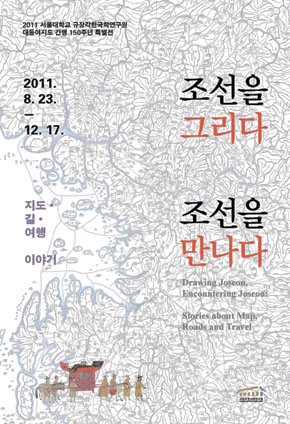 The Kyujanggak Institute for Korean Studies, located at SNU, is currently holding this year's annual special exhibition under the theme,"Drawing Joseon, Encountering Joseon" -- its main items of exhibition being old maps and travel records from the Joseon era (1392-1910). Since 2009, Kyujanggak has been hosting such exhibitions to introduce its archives to the public. In 2009, the theme was"Document Culture," and in 2010 it was"The Korean Empire Period."
The Kyujanggak Institute for Korean Studies, located at SNU, is currently holding this year's annual special exhibition under the theme,"Drawing Joseon, Encountering Joseon" -- its main items of exhibition being old maps and travel records from the Joseon era (1392-1910). Since 2009, Kyujanggak has been hosting such exhibitions to introduce its archives to the public. In 2009, the theme was"Document Culture," and in 2010 it was"The Korean Empire Period."
This year's theme was selected in commemoration of the 150th anniversary of the creation of the Daedongyeojido, a famous map generally recognized to be the greatest masterpiece of Joseon cartography. In fact, Kyujanggak, mostly known only for its massive collection of written documents, also holds more than 6000 pages worth of old maps in its archives.
The exhibition consists of two parts: the first being"Drawing Joseon," where the old maps are displayed.
The highlight of this part is the Daedongyeojido. In addition to its level of perfection, its details accurate enough to match even modern day maps, the Daedongyeojido is famous among Koreans for the legendary workmanship of its creator, KIM Jeong-ho. It is said that he created the map by walking around the entire peninsula, recording what he actually saw. Recent studies have found that this is not entirely true, showing that the map is the result of compiling well organized geographic knowledge and measuring technology, rather than a one-man job. Still, the exhibition does show that KIM Jeong-ho did not stop correcting his map until it was perfect.
"The Daedongyeojido was carved into woodblocks, making it reproducible. There are six copies of the map that remain today on paper, but we recently found out that they were all different, meaning that the woodblocks were modified and corrected at least several times after its creation. By displaying all six copies in one place for the first time, we can let the visitors actually see the minute process of perfecting the Daedongyeojido," said CHO Kye-young, the director of the exhibition.
The other maps in the exhibition display the expansion of geographical knowledge in the Joseon era, which eventually led to the creation of the Daedongyeojido.
The second part of the exhibition,"Encountering Joseon," displays travel records, such as diaries and pictures. It shows how the king traveled when he had business outside the palace, records of tourism at Mt. Geumgang, and finally, how foreigners described Korea.
The Kyujanggak Institute for Korean Studies is a massive archive of documents generated in the Joseon era, as well as a research and education institute for Korean studies. It was first founded in 1776 as the royal library of the Joseon dynasty by King Jeongjo. Kyujanggak's collections contain over 260,000 items, such as The Annals of the Joseon Dynasty (Joseon Wangjo Sillok) and the Diary of the Office of Royal Secretaries (Seungjeongwon Ilgi), both designated UNESCO Memory of the World documents.
Recently, another piece of Kyujanggak's collection was added to the UNESCO Memory of the World Register, namely
Kyujanggak (Bldg. no. 103) is the traditional Korean-style building located near the College of Law and the University Cultural Center. The exhibition hall is on the first basement level and is open Monday through Saturday, 9:30~17:30. The exhibition continues until December 17.
Written by KIM Jaeseung, SNU English Editor, brainophone@naver.com ?
Reviewed by Eli Park Sorensen, SNU Professor of Liberal Studies, eps7257@snu.ac.kr
Proofread by Brett Johnson, SNU English Editor, morningcalm2@gmail.com

